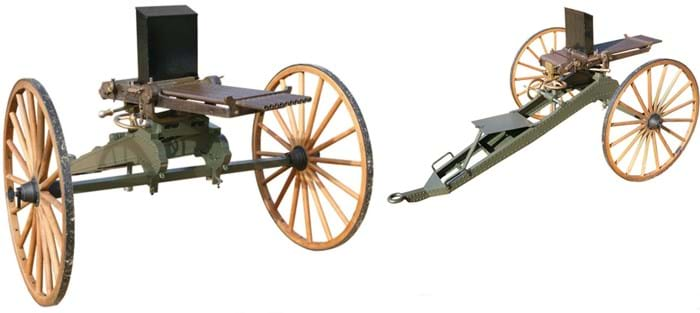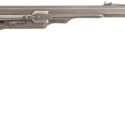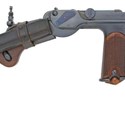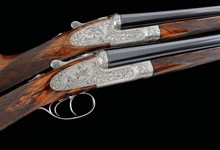Hammer highlights and preview
With its 10 .43 calibre barrels capable of firing nearly 1000 rounds a minute, the dominant presence in the sale was the extremely rare Nordenfelt machine gun of 1884, right, which was offered as the final lot of the day and sold at £65,000 (estimate £50,000-70,000).
The horizontally mounted barrels fired in turn from left to right, fed with ammunition from a tall black hopper above and operated by a lever on the right-hand side.
This mechanism was mounted on a carriage and trail of riveted steel with wooden-spoked wheels. Both carriage and ammunition hopper were expertly-made replacements.
Nordenfelt guns of this type were used by British forces in Egypt.
Like many pioneering rapid-fire weapons, they seem to have gained a reputation for jamming, but their useful life was also shortened by the appearance of the Maxim gun and by 1888 the Nordenfelt Gun and Ammunition Company had merged with Maxim.
Their short service life has made them all the more rare and collectable, hence the substantial price, although this was a touch lower than the £72,000 made by the same gun in the same saleroom in 2010.
Another rare harbinger of the proliferation of the rapid-fire weapons which were to revolutionise warfare in the 20th century was the Borchardt Patent self-loading pistol, which was acknowledged as a technical masterpiece and had some commercial success in the 1890s.
As with the Nordenfelt gun, however, it was judged to be unwieldy in use and was overtaken by other designs which found more favour with the military. As a result, Borchardt patent pistols are rare and the example in the Daedalus collection, in excellent condition and complete with shoulder stock and leather holster, sold for £15,000.
Another early automatic which is now extremely rare, having been tested but ultimately rejected in military trials, is the Bergman 7.8mm, again offered here in excellent condition with combined stock and holster, which made £10,000.
Both these early automatics had been bought for the collection at James D Julia auctions in Maine during the past 6-8 years, as had many other weapons in the sale, including a trio of rare Colt revolver rifles.
Although the revolver system was found to be perfectly satisfactory for pistols, it was less successful in longbarrelled rifle applications. Hence the rarity of the .44 Colt Paterson Second Model ring-lever eight-shot revolving rifle c.1838-41, above left, which sold for £12,000, the .36 percussion Colt 1855 model sidehammer six-shot revolving sporting rifle c.1856-59 which made £10,000 and the .56 percussion Colt 1855 model ‘British’ five-shot revolving carbine c.1856-64 at £12,000.
Repeating rifle success
The repeating rifle that did become the great commercial success of the 19th century was the Winchester, with its tubular magazine and underlever action.
The outstanding example of this rifle in the Daedalus collection was notable, not for its technical rarity, but for its historical associations.
A .44 Winchester 1873 late First Model, offered with a fringed buckskin case of Native American origin, was accompanied by documentary evidence indicating that it was acquired by Moses A Welch. He was working at “the Blackfoot Indian Reservation in Montana Territory and got the gun after it was surrendered by an Indian warrior who helped kill General Custer and his men”.
This association with the Battle of the Little Big Horn was enough to take bidding to £13,000. PISTOLS are inherently inaccurate at long range but very handy and effective at short range. Throughout their history there have been concerted efforts to improve their performance in both directions, as shown in the selection of pistols from recent sales illustrated here.














